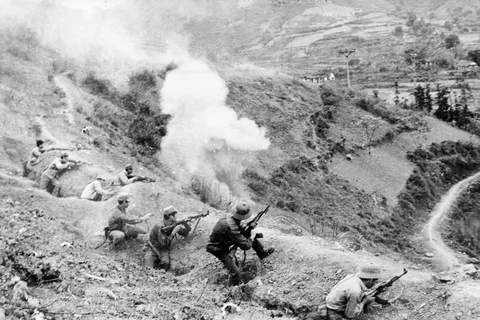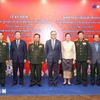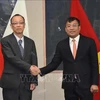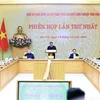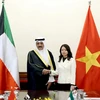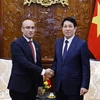Hanoi (VNA) – On February 17, 1979, China launched a large-scale attack on Vietnam’s territory along all the northern border line shared by the two countries from Phong Tho (Lai Chau province) to Mong Cai (Quang Ninh province).
Exercising their legitimate right to defence, Vietnam’s army and people fought back with great fortitude.
Suffering heavy losses without achieving the initial goal of the attack while being condemned by the world opinion, China withdrew all its military forces from Vietnam on March 18 that year.
On the occasion of the 40th anniversary of Vietnam’s war to defend its northern border, Dr Tran Huu Huy, member of the Vietnam Association of Historical Sciences, analysed the victory and historic lessons drawn from the war.
*An unjust war on the side of China
China is a neighbour of Vietnam. People of the two countries supported and helped each other during their respective revolutionary causes. But after Vietnam won the anti-US resistance war for national liberation in 1975, bilateral ties gradually degraded. In early 1979, when the Vietnam People’s Army defeated the reactionary Pol Pot gang and rescued the Cambodian nation from genocide, China and some other countries tried to distort the presence of Vietnamese voluntary soldiers in Cambodia, with the aim of undermining Vietnam’s revolution and backing reactionary forces, thus imposing their own interests in the Indochinese peninsula.
The international circumstances at the time also saw complicated developments, with contradictions between the Soviet Union and China intensifying while China-US ties improved and both countries considered the Soviet Union their Number One enemy.
Following a series of small scale military provocations, on February 17, 1979, China mobilized 600,000 troopes, more than 500 tanks and armoured vehicles along with thousands of artillery weapons to launch an attack on Vietnam’s territory along the entire border line shared by the two countries.
China had several aims behind the assault. First, it wanted to force Vietnam to pull its voluntary troops out of Cambodia, thus giving some room for the Pol Pot army to recover and keep their remaining bases to continue fighting the newly-established revolutionary administration in Cambodia.
Second, it hoped to win support from some powers hostile to Vietnam, including the US, for its scheme of “four modernization”.
Third, China intended to damage Vietnam’s economic and defence strength, incite disturbance in Vietnam and lower Vietnam’s military and political prestige in the international arena.
Fourth, China wanted to show off its strength to countries in the Southeast Asian region, while sounding out the reaction of the Soviet Union and the world opinion in preparing for later military manoeuvres.
*Vietnam’s legitimate right to defence
Immediately after the victory of the anti-US resistance war for national liberation in 1975, many high-level delegations of Vietnam, including General Secretary of the Communist Party of Vietnam Central Committee Le Duan, visited China and affirmed that Vietnam always bears in mind with deep gratitude the great support and help that China’s Party, State and people had given to Vietnam during the two resistance wars for national liberation. The Vietnamese delegations also reiterated the importance that Vietnam attaches to the friendly neighbourliness and cooperation with China.
At the end of 1978 and in early 1979, amidst tension in bilateral ties and continuous small military conflicts along the border, Vietnam persistently appealed to China to hold negotiations to address disputes and contradictions in a peaceful manner on the basis of equality and respect for each other’s independence and national sovereignty and integrity. Despite Vietnam’s good will, China pursued an anti-Vietnam policy, cut all committed aid and put out unreasonable demands in negotiations. At the same time, it continued to spread slanderous propaganda against Vietnam and declared that it wanted to teach Vietnam a lesson.
Forecast the possibility of a war, at the end of 1978, Vietnam shored up its defence forces along the northern border. When China started the full-scale attack, the Vietnamese Government issued a statement the same day, declaring that the Chinese authorities are acting against the people’s interest, seriously damaging the solidarity and friendship between the two countries. The statement stressed that Vietnam had no other choice than to exercise its just right to defence.
In the first days of the war, Vietnam did not use the strategic reserve force for fighting, neither did it mobilise the mobile main force from the south. Instead, the country mobilized the combined strength of the local militia forces and on-the-spot forces of Military Regions 1 and 2, along with some units from the rear.
Ten days into the war, the armed forces of Military Regions 1 and 2 and militia in northern border localities fought bravely, thus foiling China’s intention of “quick attack, quick occupation” and forcing China to use its strategic reserve force.
With the advantages of large number of troops equipped with many weapons, Chinese forces advanced deeply into Vietnam’s territories and occupied several key townships such as Lao Cai town (on February 19), Cao Bang (February 24), Cam Duong (February 25) and Lang Son (March 5).
In such an urgent situation, Vietnam decided to use its key army corps and got ready to open large-scale counter-attacks. In early March 1979, the Central Military Commission and the Defence Ministry order the Army Corp No 2, which was performing its international mission in Cambodia, to move all its units to the northern region, and issued a decision dated March 2, 1979 on establishing Army Corp No 5 right at the border battlefield. Key units of Army Corp No 1, the Air and Air Defence Force and other technical arms were order to get prepared to join battle.
On March 4, 1979, the National Assembly Standing Committee issued a decision on a general mobilization to defend the country.
Suffering from heavy losses while failing to achieve the basic set targets, and at the same time being condemned by world opinion, China declared the withdrawal of troops from Vietnam on March 5, 1979.
To show good will and the wish to restore the friendly ties between the two countries, the Party and Government of Vietnam ordered the armed forces and people in the northern border region to stop their counter-attack campaigns to allow Chinese troops to withdraw. As of March 18, 1979, China completed the pull-out from Vietnam.
*Historical lessons from the victory
The northern border defence war took place in just a little more than one month (from February 17 to March 18, 1979) but it has significant meanings.
Vietnam’s military and people put out of combat 62,500 Chinese troops, destroyed 550 military vehicles including 280 tanks and armoured vehicles, and demolished 115 artillery pieces, forcing the enemy army to withdraw early, thus defeating the intention of the Chinese authorities to impose their interests on the Indochinese peninsula.
The fight once more reiterated the firm will and strength of the Vietnamese people in overcoming all hardships and challenges to safeguard the country’s independence, sovereignty and territorial integrity.
The northern border defence war contributed to proving the sound political and military policies, and the sharp and skillful strategic leadership of the Party’s Politburo and the Central Military Commission.
During the war, the Party Central Committee and Government of Vietnam always asserted the country’s legitimate right to defence and the resolve to fight any attacks on Vietnam’s sovereignty, while demonstrating magnanimity, the aspiration for peace and the wish to end conflict to build good relations between the Vietnamese and Chinese nations, thus contributing to preserving a peaceful and stable environment in the region and world as a whole.
Vietnam also suffered from heavy losses during the war, with more than 30,000 military members killed and injured, and tens of thousands of civilians losing their lives. The four towns of Cao Bang, Lang Son, Cam Duong and Lao Cai were almost flattened out. A total of 320 communes, 735 schools, 41 State farms, 81 factories and mines and 38 forestry farms were destroyed. About half of the 3.5-million population in the six northern border provinces lost their homes, assets and means of living during the war.
According to Dr. Tran Huy Huy, various lessons can be drawn out from the northern border defence war in 1979, one of which is to keeping up vigilance while following the guideline of independence and self-reliance. The war also taught Vietnam to build strong defence regions and combine traditional military techniques with modern warfare, as well as the humanistic ideology of the country’s ancestors and the revolutionary heroism in the Ho Chi Minh era.-VNA
VNA

